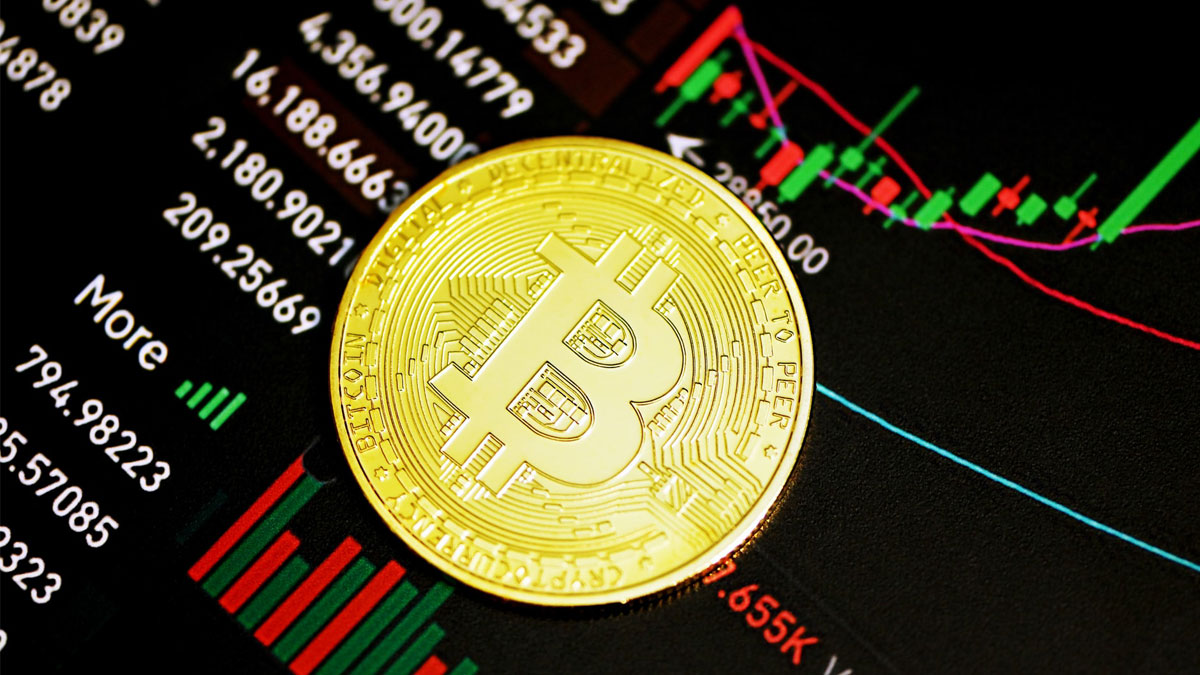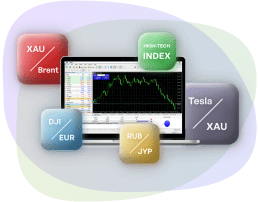- Education
- Learn to Trade Crypto
- How to Trade Bitcoin
How to Trade Bitcoin

What is Bitcoin Trading
Bitcoin trading is speculation on the movement of its price. Initially buying Bitcoin was through exchange in hopes of the price rise, to sell and profit from it.
In time traders started using derivatives that allowed speculation on both, price rise and fall which, in turn, doubled chances to profit from cryptocurency's volatility.
With IFC Markets traders can open positions using CFDs and take advantage of price movements in both directions. While trading with CFDs traders don't need to take ownership of the bitcoin; having the responsibility for the security of bitcoin tokens.
KEY TAKEAWAYS
- To be successful in trading cryptocurrency CFDs traders should learn what moves Bitcoin’s price.
- The choice of bitcoin access method determines the trading strategy.
- Exchanges are the simplest way to sell bitcoin.
- Trading cryptocurrencies can be done on a speculative basis, usually by trading on the prices of cryptos via CFDs.
How to Trade Bitcoin
To be successful in trading cryptocurrency CFDs, especially Bitcoin, traders need to understand factors affecting its price:
1. Traders Should Learn What Moves Bitcoin’s Price
Breaking news - issues with the security, value, and longevity of bitcoins can have a negative impact on the overall market price of the Bitcoin.
Key events - such as regulation changes, security breaches and macroeconomic Bitcoin announcements.
Bitcoin demand growth - based on its integration into new payment systems, which will have a positive effect on bitcoin’s price.
2. Choose Bitcoin Trading Strategy
When you decide to trade cryptocurrencies, start with strategies. You can start with the most used and time-tested strategies, and later on you can make some changes to make it more suitable to your trading style.
- Crypto Day Trading
- Arbitrage Crypto Strategy
- Smart Trading
- Automated Trading
- HODL
3. Choose How You Want to Access Bitcoins
You can access bitcoins in two different ways:
Bitcoin derivatives trading - Traders will be speculating on Bitcoin's price with CFDs. As a result, traders will be able to take a position on Bitcoin’s price by going long or going short.
Buying bitcoins through an exchange - means that trader is taking direct ownership of bitcoin – with the expectation that its price will rise. Basically, Bitcoin exchanges are used for HODL strategy.
4. Deciding on Whether to go Long or Short (Buy or Sell) Bitcoin
Thanks to derivative financial instruments, traders can open both long and short positions, depending on the current market state. Going long means traders expect the price of bitcoin to rise, and going short means traders expect the price to fall.
5. Implementing Risk Management Strategy
Trading Bitcoin carries a real risk of losing money. Traders understand this perfectly well, so it’s inherent to use risk management.
Stops and limits are crucial risk management tools when trading CFDs on cryptocurrencies.
Let's take a look at a list of some of the rules to follow to reduce your risk. It is quite possible that you may have used these methods without suspecting that they are valid risk management steps.
- Use a stop loss-order - protects your trades from unexpected market movements.
- Use a take-profit order - Take Profit aims to automatically close a deal when a certain profit is reached.
- Don't risk more than you can afford to lose - traders only allowed to risk up to 1% of their trading account per one trade.
- Don't overdo it with leverage - crypto market is unpredictable and leverage can cause huge damage in the event of an unexpected change in the market.
- Have realistic profit expectations - One of the main reasons that novice traders take big risks is because they have unrealistic profit expectations, which forces them to risk much more than necessary.
- Create a risk management plan - it should include answers to these questions - when to enter a trade, when to exit a trade, what is the minimum risk-reward ratio, what part of your account you are willing to risk in a trade.
- Prepare for the worst scenarios - You should always be prepared for the worst-case scenario in the market and have a backup plan in place.
- Control your emotions - Emotional traders find it difficult to adhere to trading rules and strategies.
- Diversify your asset portfolio - A diversified portfolio will protect you in the event of a market crash. You can hope that the decline will be offset by other markets that may have stronger results.
And the last one, never stop learning - check out online webinars, read educational articles, research new trading strategies, watch video lessons.
6. Monitor the Position and Close it to Take a Profit or Cut a Loss
Traders need to keep an eye on the market to make sure it moves the way they expected. Thanks to the technical indicators available on our trading platform, it is possible to determine where the price of Bitcoin can go next. Indicators can also help you monitor current market conditions such as volatility levels or market sentiment.
after
Close a position to make a profit or cut a loss that has reached a level that is no longer acceptable to you. Thereafter, your profits will be paid directly to your trading account, while losses will be deducted from your account balance.
How to Sell Bitcoin
If you bought a few coins and were waiting for the price to rise and now want to sell them, there are several ways to sell bitcoins, each with its own advantages and disadvantages, so you should consider which one is right for you before continuing.
There is a difference between buying/selling cryptocurrency on an exchange and trading cryptocurrency CFDs. Both are obviously used to profit from trading on the crypto market, but the processes are very different.
Below we will talk about how to buy and sell cryptocurrencies, as well as how to trade cryptocurrency CFDs.
Cryptocurrency Exchanges
Exchanges are the simplest way to sell bitcoin. The trades are almost instantaneous, you can get up-to-date information as you trade, there’s little chance that it goes really poorly, and you probably already have an exchange account that you used to buy the coins in the first place.
However, exchanges aren’t the best for everyone. In order to keep the service running, it has to charge a fee, so it isn’t always the cheapest. It’ll also limit you to only certain payment methods, and there will be a centralized organization of some kind monitoring the transaction — the exact thing many cryptocurrency users are against
Online P2P Trading
Peer-to-peer (P2P) exchange lets traders choose their price, and the platform helps find a buyer willing to pay it, then both parties decide between them how to pay. It could be done on the site — often called direct trades — but normally, would be use a separate bank transfer.
One of the advantages of P2P trading is the possibility to sell cryptocurrency without the limits of an exchange. Unfortunately there are some problems around this, such as what happens if the buyer doesn’t pay up, and the peer-to-peer marketplaces will still have some information on who the traders are.
Bitcoin ATM
For those who want to avoid prying eyes can pull cash from bitcoin ATMs, because it is much harder to trace than a bank transfer, these ATMs can also be used to buy bitcoin, provided that there is one nearby. However, traders are very dependent on ATMs being near them; if trader ever move, then transactions will be far behind the fast movements of the market.
Trading Cryptocurrency CFDs
Trading cryptocurrencies can be done on a speculative basis, usually by trading on the prices of cryptos via CFDs. Actual cryptocurrencies are not actually owned or exchanged by the trader; it's a process that involves buying or selling contracts based on the price movements of the Bitcoin.
Trading of cryptocurrency CFDs is done via online platforms of CFD issuers such as IFC Markets.
The trader needs to open an account, fill in an online form. Funds can only be deposited onto the CFD trading account using fiat currency methods through various payment methods.
For exampleIf you want to trade BTCUSD
You will have to go through the process of deposits and withdrawals made when trading cryptocurrency CFDs.
You should know that brokers that offer cryptocurrency CFD services can only accept fiat currency deposit and withdrawal methods. Transactions on these platforms can be made using bank transfers, credit cards or e-wallets. Please note that anonymous funding is not allowed.
Third party payment methods are also not allowed. Each deposit channel has transaction limits. Bank transfers usually have unlimited deposit and withdrawal options, but bank cards and e-wallets may have limits set by the CFD provider.
You will have to go through the process of trading cryptocurrency CFDs
Once you have funded your CFD trading account, you will be able to trade Cryptocurrency CFDs in two ways, namely, you can benefit from rising prices by buying low and selling high, or you can benefit from falling prices by selling high and closing low.
Conversely, positions will close at a loss if market prices move against you. You can either trade at current prices, or use the future order feature to trade when the instrument reaches the specified price.
Bottom Line on How to Trade Bitcoin
There are two ways to interact with the cryptocurrency market, either by buying/selling on a cryptocurrency exchange, or by trading cryptocurrency contracts on an online CFD platform.
If you are more interested in learning how to trade Cryptocurrency CFDs, it only takes a few minutes to open a CFD demo account with IFC Markets, where you can then choose your preferred crypto instruments from the wide range of offers available.
Crypto FAQs
What is Cryptocurrency Trading?
Cryptocurrency trading is the exchange of digital currency between traders. The fluctuations caused by supply and demand allow traders to profit from it. Cryptocurrency trading is both risky and rewarding due to its volatility.
How to Trade Cryptocurrencies?
You’ll need to open an account with a crypto brokerage company. The next step is to choose a trading platform. After that choose crypto to invest in and strategy to trade with. Final step is to store your cryptocurrency.
Can you Trade Crypto 24/7?
Yes. Cryptocurrency markets are open 24 hours a day, 7 days a week all year round. Traders have the opportunity to buy and sell without restrictions as the cryptocurrency markets do not close.
What are Most Traded Cryptos?
These are the 5 most traded cryptos all over the world
- Bitcoin - Market cap over $846 billion
- Ethereum - Market cap over $361 billion
- Tether - Market cap - over $79 billion
- Binance Coin - Market cap - over $68 billion
- XRP - Market cap - over $37 billion
What is Cryptocurrency Market?
Cryptocurrency is a form of decentralized currency and It's a completely digital asset. At its core, cryptocurrency uses blockchain technology to generate code segments that are unique for each transaction, just like serial numbers. Every time cryptocurrencies exchange hands, code segments are written to a decentralized ledger.





